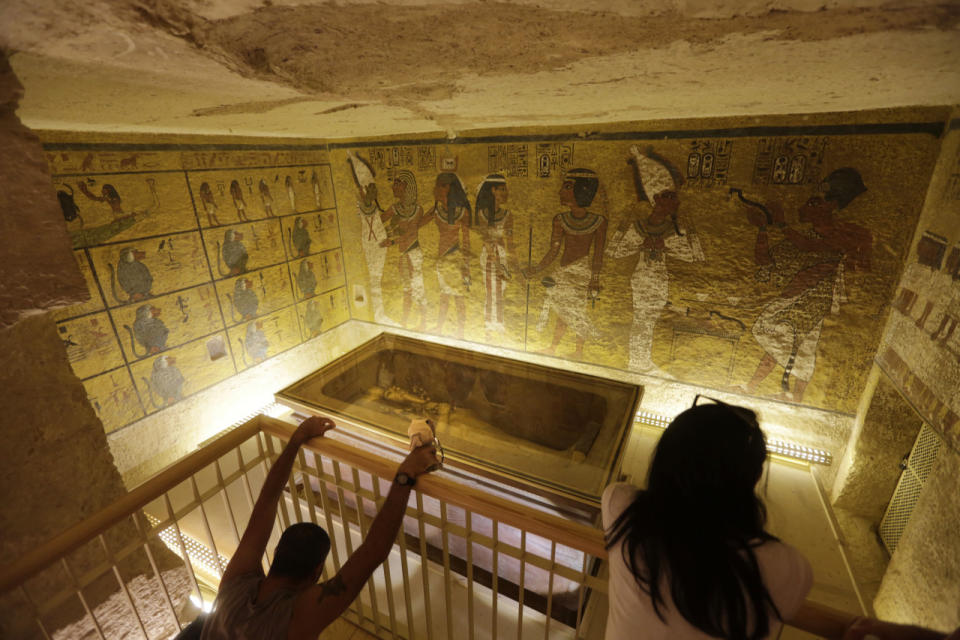Egypt Says 90 Percent Chance of Hidden Rooms in King Tut Tomb

The entrance to King Tutankhamun’s tomb. (Photo: iStock)
by Nour Youssef
Egypt on Saturday said there is a 90 percent chance that hidden chambers will be found within King Tutankhamun’s tomb, based on the preliminary results of a new exploration of the 3,300-year-old mausoleum.
Researchers say the discovery of a new chamber could shine new light on one of ancient Egypt’s most turbulent times, and one prominent researcher has theorized that the remains of Queen Nefertiti might be inside.
Egypt began the search for the hidden chamber last week. Announcing the results of three days of testing in the southern city of Luxor, Antiquities Minister Mamdouh el-Damaty said the findings will be sent to Japan for a monthlong analysis before the search is resumed.
Related: What Is Life Really Like In Egypt?
Luxor, in southern Egypt, served as the pharaonic capital in ancient times, and is home to sprawling temples and several ancient tombs.
British Egyptologist Nicholas Reeves theorizes that Tutankhamun, better known as King Tut, who died at the age of 19, may have been rushed into an outer chamber of what was originally Nefertiti’s tomb. Famed for her beauty, Nefertiti was the subject of a famous 3,300-year-old bust.

In this Nov. 5, 2015 photo, tourists look at the tomb of King Tut. On Saturday, Nov. 28, Egyptian Antiquities Minister Mamdouh el-Damaty said there is a 90 percent chance that hidden chambers will be found within King Tutankhamun’s tomb. (Photo: Amr Nabil/AP)
Reeves reached his theory after high-resolution images discovered what he said were straight lines in King Tut’s tomb. These lines, previously hidden by color and the stones’ texture, indicate the presence of a sealed chamber, he said. The images were later broadcast live on national television last September.
Nefertiti was the primary wife of the Pharaoh Akhenaten, who unsuccessfully attempted to switch Egypt to an early form of monotheism. Akhenaten was succeeded by a pharaoh referred to as Smenkhare and then Tut, who is widely believed to have been Akhenaten’s son.
Tut, Nefertiti, and Akhenaten’s family ruled Egypt during one of its most turbulent times, which ended with a military takeover by Egypt’s top general at the time, Horemheb. The whole family’s names were wiped out from official records later on.
Related: Google Maps’ New Conquest: Street View Takes You to Ancient Egypt

Another view of the tomb of King Tut, on display in a glass case at the Valley of the Kings in Luxor, Egypt. (Photo: Nariman El-Mofty/AP)
Reeves believes that Smenkhare is actually Nefertiti.
This is the second find to be announced this week. On Tuesday, el-Damaty said the Austrian Archaeological Institute discovered a “giant fence” dating back over 3,500 years at the site of another ancient capital city, Avaris. The sandstone fence is least 500 meters (yards) long and 7 meters (yards) thick, antiquities official Mahmoud Afifi said.
WATCH: Go Now: The New Seventh Wonder of the World — That’s Empty
Let Yahoo Travel inspire you every day. Hang out with us on Facebook, Twitter, Instagram, and Pinterest. Check out our original adventure travel series A Broad Abroad.
